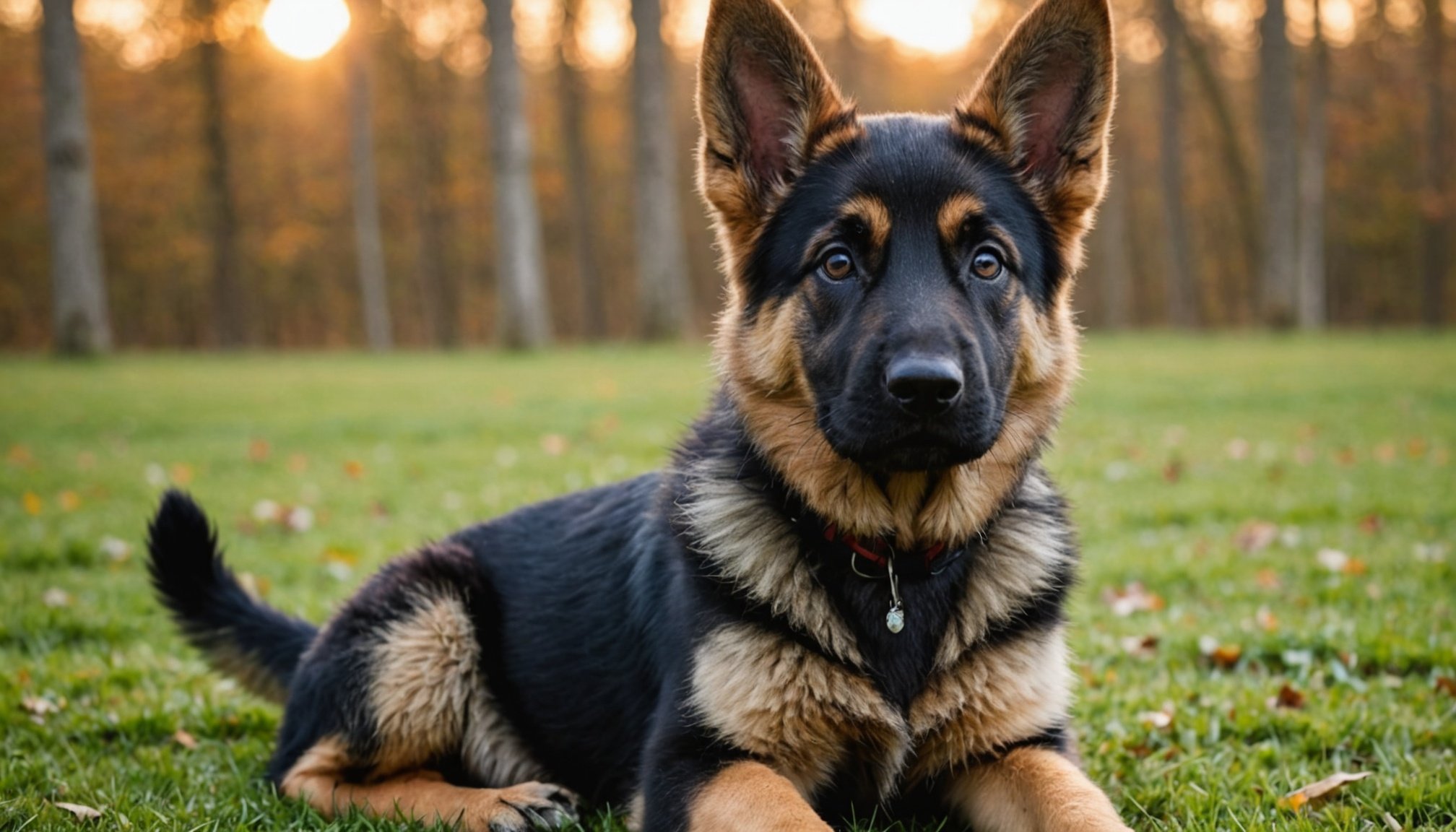Understanding Your German Shepherd’s Behavior
Recognizing German Shepherd behavior is essential when introducing them to new family members. These intelligent dogs often rely on their innate canine instincts to interpret their surroundings. Paying close attention to their dog body language can provide insights into their emotional state.
During introductions, observe for common signs such as wagging tails or relaxed ears, which generally indicate comfort. Be mindful of more subtle cues—such as lip licking or yawning—that might suggest anxiety or discomfort. These signals often stem from their desire to understand where they fit within the family hierarchy.
A lire aussi : Unlocking Training Potential: How to Channel the Prey Drive of Your Finnish Spitz
Canine instincts play a pivotal role, especially with babies. A dog may exhibit protective behavior, sometimes accompanied by a heightened state of alertness. Understanding this instinct can be beneficial, yet needs to be managed to ensure harmonious interactions.
Assessing your dog’s comfort level with the baby involves a combination of observation and gradual desensitization. Note how your German Shepherd reacts to the baby’s sounds and movements. Positive reinforcement, like treats or praise, when calm behaviors are observed, can encourage a peaceful relationship over time. Engaging your German Shepherd in structured activities can further ease any tension, allowing them to adjust to their new environment.
En parallèle : Smart Nutrition Strategies for Energizing Your Diabetic Chihuahua Without Sacrificing Their Diet
Preparing Your Home for a New Baby
When welcoming a new baby into your home, baby-proofing and dog-proofing become crucial tasks. Ensuring the safety of both your baby and your German Shepherd requires foresight and some essential modifications. By managing your space effectively, you can create a harmonious environment.
First, identify hazards on the floor where your baby might crawl, as your German Shepherd’s toys can be a tripping hazard. Safely store dog toys to avoid any accidents. Installing baby gates is a smart move for restricting access to certain areas, giving your baby and pet their own safe spaces.
Creating designated spaces for both your baby and your dog fosters a sense of security. Consider setting up a baby zone in a quieter room to reduce stress and noise. A designated dog area will help your German Shepherd understand its boundaries while maintaining a close bond with the family.
Investing in reliable tools and products can significantly assist in this transition. Look for corner protectors, outlet covers, and cabinet locks. For your pet, ensuring they have a comfortable bed and toys that don’t pose choking hazards is key to safe cohabitation. Space management techniques, such as using organisers, can also optimise your living area for seamless daily routines.
Training Your German Shepherd for a Positive Introduction
Preparing your German Shepherd for an introduction involves teaching key obedience commands that set the foundation for good behaviour. Commands such as “sit”, “stay”, and “come” are essential for controlling situations and ensuring your dog’s attention is focused on you. These are not just for show; they are necessary for managing interactions smoothly.
Incorporating positive reinforcement in your training routine can greatly affect how your German Shepherd responds to commands. Rewarding your dog with treats, praise, or playtime when they exhibit the desired behaviour encourages them to repeat these actions. This method builds a positive association with following commands and helps in reducing anxiety during new experiences.
If training your dog becomes overwhelming, consider enlisting professional help. A certified dog trainer can provide valuable insight into tailored training methods and address specific behavioural issues. This approach not only guides you through the process but also enhances your dog’s learning atmosphere, promoting successful introductions. Never hesitate to seek expertise, as it can significantly ease the stress for both you and your German Shepherd. The right guidance ensures the training process is effective and enjoyable, leading to harmonious social experiences for your furry friend.
Step-by-Step Introduction Process
When it comes to introducing a baby to a new environment, employing effective introduction techniques is paramount. The process should begin with structuring the introduction phase to minimise stress for both the child and caregivers. Start with short, supervised sessions that gently acclimate the baby to unfamiliar surroundings or individuals.
Using gradual exposure is a proven technique for easing this transition. Introduce the baby to new people in a familiar setting, progressively increasing the duration of these interactions. This method fosters a sense of security and trust, reducing anxiety and encouraging comfort.
Always prioritise safe interactions by closely monitoring and assessing the baby’s behaviour and responses. Be attentive to cues such as changes in mood or body language. These observations will help caregivers gauge the baby’s comfort level, allowing necessary adjustments to the introduction process.
Key steps include:
- Begin with brief introductions.
- Gradually increase the duration of exposure.
- Monitor reactions to ensure safety and comfort.
Each phase of the introduction should be paced according to the baby’s responses, tailoring the process to suit their individual needs while fostering a nurturing environment.
Ongoing Monitoring and Adjustments
Ensuring a harmonious relationship between your dog and baby requires consistent behavior monitoring. Pay close attention to their interactions. Notice if the dog is relaxed or showing signs of stress. This can help pre-empt any issues before they escalate. Early identification of discomfort allows for routine adjustments. You might consider altering playtimes or creating designated baby-free zones where your dog can retreat.
Recognising red flags is crucial. Signs such as growling, tensed body language, or avoiding the baby suggest that intervention is needed. Swift action protects both your dog and your child, preventing negative experiences. In these scenarios, develop and implement effective safety strategies. Training your dog to respond to specific commands or providing positive reinforcement for desired behaviours might help.
Routine adjustments based on your observations support ongoing safety and comfort for both parties. This could mean altering the dog’s daily schedule. Perhaps a walk before baby playtime will help expend energy, increasing tolerance and patience. Remember, successful behavior monitoring and intervention enhance the safety and comfort of your baby’s environment while also maintaining your dog’s well-being.
Encouraging Positive Interactions Between Baby and Dog
Ensuring a harmonious relationship between your baby and dog requires proactive measures, such as engaging in structured socialization activities. Shared experiences can significantly contribute to building mutual trust and affection. Regular bonding activities, including supervised walks or gentle play sessions, can help both your baby and dog understand each other’s boundaries and behaviours.
Supervised play is crucial for avoiding miscommunications that could lead to undesirable outcomes. By overseeing these interactions, you can guide both parties in learning to communicate positively. This setting allows you to immediately intervene if necessary, ensuring the relationship develops kindly and effectively.
Incorporating bonding activities like family hikes or interactive games can also be beneficial. These experiences create positive associations, reinforcing the concept that time spent together is enjoyable and rewarding for both dog and child. Over time, consistent, positive interactions will naturally nurture a strong bond, creating a household atmosphere full of trust and affection.
Focusing on these activities empowers both the baby and dog to form connections that will evolve as they grow. Trust and affection aren’t built overnight, but with patience and consistent involvement, they are well within reach.
Expert Insights and Personal Experiences
When it comes to introducing a new dog into your household, particularly with children or other pets, expert advice can be invaluable. Veterinarians and dog trainers often suggest gradual introductions to avoid overwhelming any involved parties. They advise starting with controlled environments where the child or existing pet can observe the new dog from a safe distance. This gradual approach allows everyone to become accustomed to each other’s scents and energies.
Parenting tips often include setting boundaries for both children and pets. Experienced dog owners share stories of teaching their kids to respect the animal’s space and recognising signs of discomfort. Such pet owner stories are crucial in illustrating real-world applications of advice, offering relatable scenarios that might resonate with others in similar situations.
Moreover, engaging in community forums or support groups where individuals share successful strategies can foster a sense of support among pet owners. Learning from others’ experiences not only builds confidence but can also prompt innovative solutions to challenges faced during the integration process. Embracing these shared experiences and expert insights can lead to harmonious coexistence between young families and their new furry family members.











